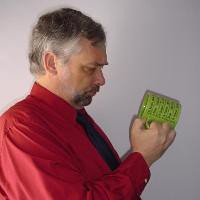Note: Visit my education blog, The Green Cup.
The concept of a spiral curriculum has changed the way I teach. I suspect that the concept will change the way most teachers teach before too much longer. And special needs students will benefit from that.
A couple of years I was introduced to a concept in teaching that, for me (and most of the other teachers in my building), was almost entirely new. The concept, the idea, is at least as old as I am. It is called a spiral curriculum.
Let me compare a spiral curriculum to the more tradition approach to teaching that people are used to. The basic idea behind the tradition approach is that the time has come for something: fractions, gerunds, state capitals, the Third Law of Thermodynamics - whatever. Because the time has come, we're going to learn it. Maybe that means we're going to memorize it (like with state capitals). Maybe that means we're going to develop a skill with it (like the addition of fractions with like denominators). Maybe that means we're going to grasp how it affects us. But whatever it means, the time is now - for EVERYONE. We're going to work on it for a while. The kids are going to learn it NOW. And then we're going to move on to the next thing that the time has come for...
In contrast, a spiral curriculum begins with the assumption that children are not always ready to learn something. Readiness to learn is at the core of a spiral curriculum. And instead of focusing for relatively long periods of time on some narrow topic whose time has come, a spiral curriculum tries to expose students to a wide varies of ideas over and over ago. For a select few, the time for gerunds and infinitives has already arrived by the second grade. And for a few, algebra and geometry make perfect sense by grade three. A spiral curriculum, by moving in a circular pattern from topic to topic within field like, say, math, seeks to catch kids when they first become ready to learn something and pick up the other kids, the ones not ready to learn yet, later - the next time we spiral around to that topic.
Why isn't a spiral curriculum a circular curriculum? Because it doesn't stay at the same difficult level as time goes by....
And it is with math that I became involved in a spiral curriculum. My school district began this year implementing a curriculum developed at the University of Chicago called Everyday Math. From the very early grades students are introduced to ideas from algebra, geometry, statistics, measurement, patterns, and so on. The challenge for the teacher? Simple: stay on track. The first time you try and explain what a variable is, NO ONE gets it. You spend the day that the book says to on it and you MOVE ON.
And THAT is HARD for someone from a traditional background. Looking at a group of kids and saying, "No one understood. Some of them will get it next time..." is hard for someone from a traditional teaching background. But there will be a next time. And a next time after that. So if Billy or Suzie isn't ready for converting improper fractions to mixed numbers this week, NOW, that's okay.
And for special needs children, that's good news...
Sunday, December 9, 2007
Subscribe to:
Post Comments (Atom)


No comments:
Post a Comment